INDIAN ARMED FORCES CHIEFS ON
OUR RELENTLESS AND FOCUSED PUBLISHING EFFORTS

SP Guide Publications puts forth a well compiled articulation of issues, pursuits and accomplishments of the Indian Army, over the years

I am confident that SP Guide Publications would continue to inform, inspire and influence.

My compliments to SP Guide Publications for informative and credible reportage on contemporary aerospace issues over the past six decades.
Target – Global Drone Hub
Innovations, Challenges, and Future Prospects of a Drone Revolution in India
 |
The Author is Former Director General of Information Systems and A Special Forces Veteran, Indian Army |
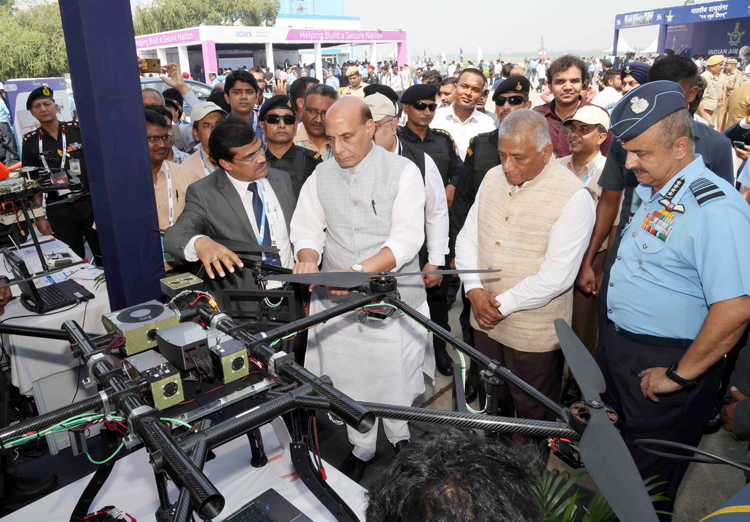
It would be fair to say that drone production in India received an impetus with China's aggression in eastern Ladakh during 2020 and witnessing the momentous role drones are playing in the war in Ukraine on a daily basis. The existing drone market revenue of $4 billion is expected to grow annually by 3.29 per cent (CAGR 2023-2028). Interestingly, China's existing drone market of $1.4 billion is expected to grow annually by 5.42 per cent (CAGR 2023-2028); in global comparison, most revenue is generated in China.
The drone market in India has been witnessing exponential growth in recent years driven by advancements in technology and its adaptation. India's existing drone market revenue is $23.6 million expected to grow annually by 7.55 per cent (CAGR 2023-2028). The Drone Policy enunciated in 2021 has committed India to become a global drone hub by 2030. However, experts believe that availability of semiconductors is likely to cause hurdles. In the defence sector, drones are being used in India for reconnaissance, surveillance, neutralizing enemy targets, counter-drone strikes and logistics.
India's drone market is experiencing exponential growth and the nation's Drone Policy aims to establish India as a global drone hub by 2030
Indigenous innovations and development of drones in India along with trials of imported drone have been covered in these columns from time to time, example of latter being Army testing Warmate drones of Polish origin in Ladakh last month, which is equipped with several different payloads, including fragmentation, HEAT and thermobaric warheads. Some of the indigenous innovations and drone developments include the following:
- Kamikaze Drone. Under the Defence Research and Development Organisation's (DRDO's) Young Scientist Laboratory (DYSL-CT) project, Indian Institute of Technology, Kanpur has developed a kamikaze drone that can deliver a payload of up to 6 kg for up to 100 km. These drones equipped with stealth technology can escape radar identification, can be launched from a catapult or canister launcher, and can operate even in the absence of Global Positioning Support (GPS) support with the help of artificial intelligence (AI)-enabled visual guidance system in enemy territory.
- TAPAS UAV. The indigenous Tactical Airborne Platform for Aerial Surveillance (TAPAS) Beyond Horizon-201 (BH-201) medium-range UAV, developed by the ADE/RDO and undergoing user trials is to meet the Intelligence, Surveillance, Target Acquisition, Tracking and Reconnaissance (ISTAR) requirements of the Armed Forces. It has an operating altitude of 30,000 feet and an endurance of 24 hours. Its capabilities extend further with the integration of high-grade military Electro-Optical (EO) and Synthetic Aperture Radar (SAR) payloads.
- Drone-SAR. SISIR Radar has demonstrated a game-changing imaging technology with the indigenous development of ultra-high resolution, L-band (SAR) on a low altitude drone platform. This SAR has a resolution of 0.75m in flight (also called Azimuth) and 1m along across flight (range direction). Usually, the best possible resolution in SAR is around 10 times the wavelength. An X band SAR can give the best resolution around 30 cm for a wavelength of 3 cm. For an L band SAR, the industry standard is around 250 cm or 2.5 m for a wavelength of 25 cm. However, SISIR Radar's SAR achieved a resolution of 75 cm or 3 times the wavelength.
- Counter Unmanned Aerial System (CAUS). The DRDO-developed CUAS has been in service since January 2020. The Naval Anti Drone System (NADS), which can instantly detect, jam micro drones and use a laser-based kill mechanism to terminate targets, was to being inducted into the Indian Navy in 2021. Media reports of January 31, 2023 stated that the DRDO-developed and BEL manufactured Drone Detect, Deter and Destroy system (D4S) is to be inducted into the Indian Armed Forces. The anti-drone system deployed of the Indian Army has a range of over 10 km. A number of private companies are also developing CUAS technology. Israel's Avnon Group's Skylock is partnering with India's DCM Shriram Industries Ltd to manufacture the former's VIP Dome Pro under the name DCM portable CUAS from 2022 and is presently testing the system.
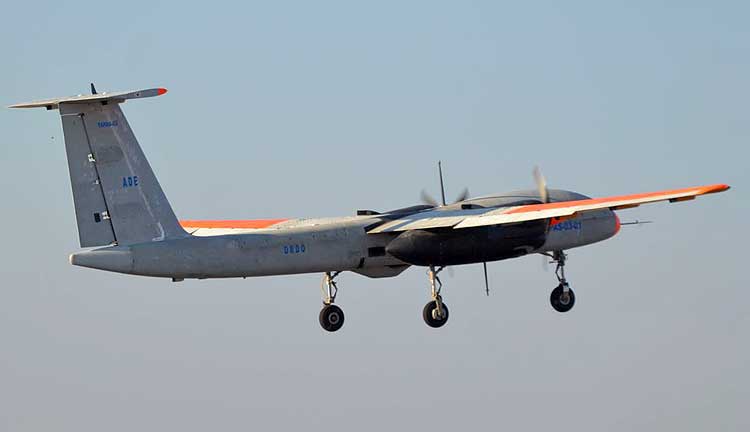

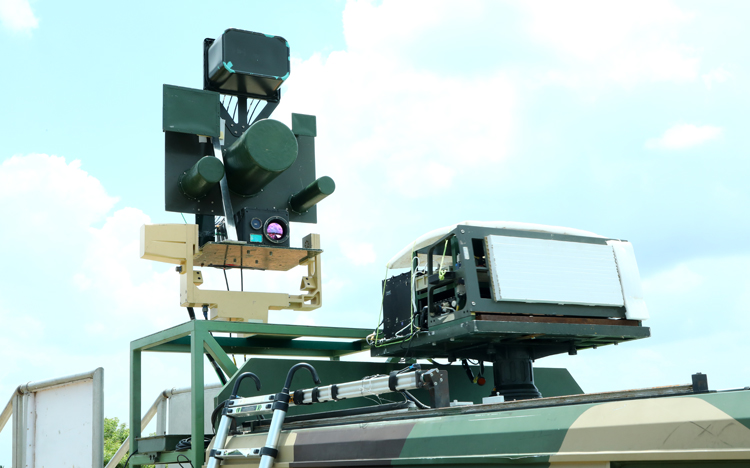
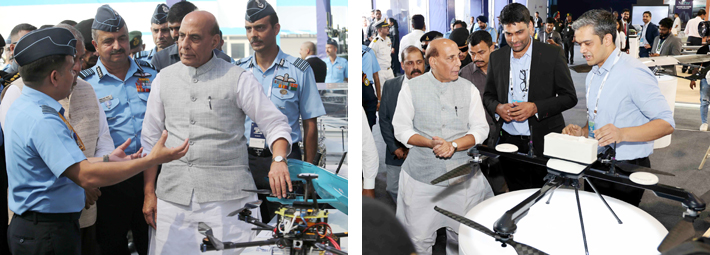
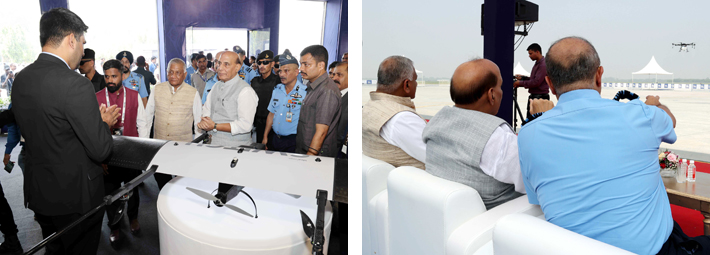
On September 25, 2023, Defence Minister Rajnath Singh inaugurated the first ever 'Drone Shakti 2023' exhibition at the Hindon Air Base in Ghaziabad in Uttar Pradesh co-organised by the Indian Air Force (IAF) and the Drone Federation of India (DFI). During the two-day exhibition, which featured over 50 live demonstrations, the defence minister also formally introduced the C295 MW transport aircraft into the India Air Force (IAF), which marked a significant upgrade to replace the ageing Avro-748 fleet.
Innovations in indigenous drone technology showcase India's capabilities, including a kamikaze drone with stealth technology and the Tactical Airborne Platform for Aerial Surveillance (TAPAS) UAV designed to meet armed forces' Intelligence, Surveillance, and Reconnaissance (ISTAR) needs
The exhibition displayed a range of drones including loitering munitions (Nagastra-1). Drone swarms, tactical surveillance drones, heavy-lift logistics drones, survey drones, agriculture drones and counter-drone solutions. With participants in the event exceeding 75 startups, the Bharat Drone Shakti 2023 exhibition showcased the growing significance of drones in various sectors, highlighting their potential for enhancing surveillance logistics, agricultural practices and security application across the country and beyond.
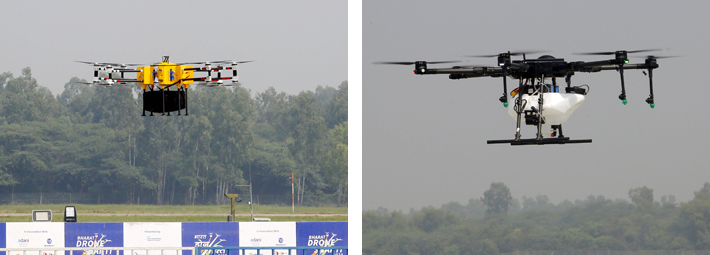
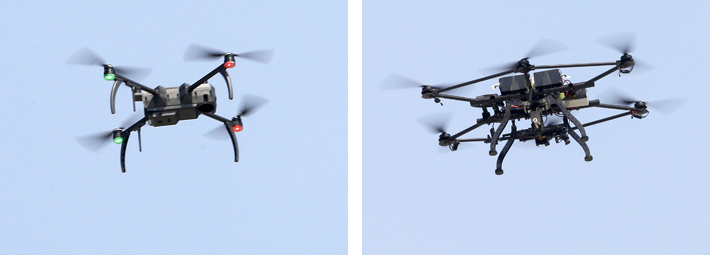
On September 26, 2023, 'Indrajaal', an autonomous CUAS firm, has announced astrategic manufacturing partnership with Hyderabad-based Sigma Advanced Systems (SAS). Under the collaboration, Sigma will be responsible for indigenously manufacturing critical hardware systems for Indrajaal's state-of-the-art drone countermeasures. The system's design principle leverages a combination of 12 unique layers of technologies powered by artificial intelligence. Indrajaal can identify threats, classify them, track them, determine the course of action and neutralize these threats in real-time. The system's design principle leverages a combination of 12 unique layers of technologies powered by artificial intelligence. Indrajaal can identify threats, classify them, track them, determine the course of action and neutralise these threats in real-time.
Concurrently, NewSpace Research and Technologies NRT) is discussing the development of the 'Abhimanyu' collaborative combat UAS concept with the Ministry of Defence (MoD) and other stakeholders. Abhimanyu is to be a low cost, intelligent and expendable platform, with a modular approach for ISR, kinetic attack, decoy and electronic warfare (EW) missions. It will be an adjunct to traditional crewed aircraft, flying collaboratively and autonomously as part of a manned unmanned teaming approach, with swarming capable operations in the contested airspace. As a system it aims to fit a notch below the DRDO's 'Ghatak' and HAL's 'Warrior' drones.
India's Defence Minister inaugurated the 'Drone Shakti 2023' exhibition, featuring over 50 live demonstrations showcasing a diverse range of drones. The event underscores the growing significance of drones across various sectors in India.
Above are good developments but in this era of mass use of swarm drones, the number of drones required is huge. The requirement of CUAS will be even more catering for the drone threat pan-India. This requires an immediate holistic appreciation and a timed roadmap to meet our national–level requirements looking at the demonstrated inadequacy of Israel's Iron Dome air defence system when faced with the barrage of rockets and inexpensive drone fired by HAMAS on October 8, 2023.
Finally, the private industries can usher self-reliance at a much faster pace, as in the US and other developed countries, but an open playing field is still not provided to them in defence production in India; currently estimated at below 35 per cent. Moreover, about 90 per cent of the domestic defence manufacturing is currently done in the public sector, leaving only 10 per cent to the private industry.





